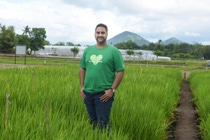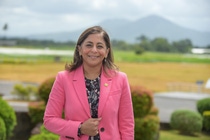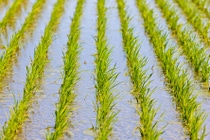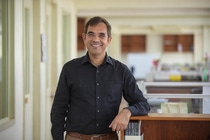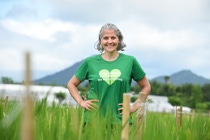Over 90%
of the world’s rice
is produced in
Asia-Pacific
Growing more using less
to support farmers in doing
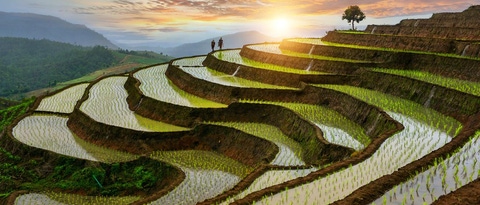
Agriculture
For centuries wet paddy rice cultivation has helped farmers tame weeds and secure harvests for billions. But this traditional method demands high amounts of water and, therefore - emits methane – a potent greenhouse gas – putting rice production as one of the strongest contributors of greenhouse gas emissions in the agricultural sector. To tackle these high emissions and reduce water consumption, alternative methods for cultivation and weed control will be needed.
Welcome to the world of rice farming – a story of balance between tradition and transformation. And like all good balancing acts, this one begins with collaboration.
For more than a century, BASF Agricultural Solutions has been supporting agriculture, farmers and growers. With a dedicated focus on rice, these efforts have empowered rice growers to achieve better outcomes through tailored agronomic solutions and sustainable agricultural practices.
Rice farming is the cultivation of rice, but in Asia it goes far beyond the field, and it is not just a staple crop. It is a livelihood for millions of smallholder farmers who depend on it not only for food, but also for income. When we talk about climate change — rising temperatures, unpredictable rains, more frequent droughts and floods — we’re not just talking about abstract global trends. We’re talking about very real, very personal impacts on the people who grow our food and safeguard the food security we all depend on.
That’s why in rice farming, sustainability isn’t just an environmental target to hit. It’s about helping farmers weather the storms — literally and figuratively — while still putting food on the table and securing their future.
Over 90%
of the world’s rice
is produced in
Asia-Pacific
It’s very important to identify products and practices that help smallholders to adapt and mitigate climate change and to secure their livelihoods. That is effectively what we are trying to do with the trials we run and the products we develop.
A key part of this transformation is an alliance between BASF Agricultural Solutions and the International Rice Research Institute (IRRI), a research organization, headquartered in the Philippines, that has been championing rice science for over six decades, guided by a mission of reducing poverty and hunger. Together, they are tackling a challenge as immense as it is urgent: how to help feed more people, with fewer emissions, while navigating a planet increasingly defined by water scarcity and extreme weather conditions.
As global rice demand rises, achieving sustainability is a complex challenge. However, we’re making tangible progress through our collective efforts.
That progress is already taking root in the fields — through hands-on trials, low-emission approaches like Direct Seeded Rice (DSR) or practices like Alternate Wetting and Drying (AWD) — a game-changing combination on how water is used in rice irrigation.
Rice consumes ~30%
of fresh water in agriculture
Imagine a rice field where the water isn’t constant. Instead, it is left to dry for a few days, allowing air into the soil, before being re-flooded. AWD does something important by doing something deceptively simple: letting the water recede. In place of the constant submersion that rice has long known, this method introduces cycles of wetting and drying. This intermittent flooding allows the soil to breathe. “The main objective, besides the obvious benefit of using less water, is that you allow a little bit of air into the soil,” explains Ligia Bacchereti Azevedo, Senior Sustainability Manager at BASF Agricultural Solutions, Germany. “By doing that, you suppress the bacteria that produce methane and that thrive in soils without oxygen. It’s a co-benefit: water conservation and emissions reduction going hand-in-hand.”
As Dr. Virender Kumar, IRRI’s Research Leader for Climate-Adaptive Agronomy, explains, this method is as effective as it is simple.
With AWD, we’re avoiding continuous flooding, which leads to anaerobic conditions. On average, we see around 30% water savings and 30-70% reduction in greenhouse gas emission, especially methane.
When we talk about AWD, the conversation naturally brings us to another alternate practice: DSR. This innovative approach to rice planting involves sowing seeds directly into the soil rather than transplanting them into flooded fields - saving water in rice cultivation and minimizing the back-breaking labor required for manual transplanting. Finally, another benefit of DSR is that it enables more efficient weed management, through the use of herbicides, helping farmers manage weeds in these drier systems. This improved weed control ultimately safeguards and can even enhance yield. This is a win-win situation for manual work, the environmental benefits, and food security all in one.
Up to 50%
less water usage
with Direct Seeded Rice and
Alternate Wetting and Drying
Water isn’t the only lever farmers can pull to cut emissions—straw management is another essential part of the puzzle. Traditionally, after harvest, rice straw is incorporated in the soil, where it continues the cycle by enriching it and supporting its health. “By removing straw before flooding begins, we can significantly cut down on emissions,” explains Dr. Virender Kumar. “IRRI has developed what we call circular economy models for straw management, because until now, most of the farmers burn it, leading to high emissions, more pollution and loss of nutrients. We are trying to introduce models where straw is reused for mushroom production, biochar, organic compost or turned into biodegradable pots instead. Like that, it can even generate extra income for farmers.”
In 2024, BASF Agricultural Solutions placed a focused effort on rice cultivation through a Global Carbon Field Trial Program. Along with IRRI, the goal was to identify practices that reduce methane emissions and water use, without compromising yields. Key findings were promising and showed that a 30% reduction in greenhouse gas intensity (GHGi) in rice is possible, and practices such as AWD, DSR, and improved straw management have proven effective in lowering emissions and water use - without reducing yield.
We wanted to create solutions that don’t just tick boxes for environmental goals.They must actually work on the ground, in the hands of the smallholder farmers who need them most.
The report demonstrated what worked but also what mattered the most in reducing emissions across diverse rice-growing regions. Read the full report here.
Rice farming is a story of balance between water and land, heritage and innovation, income and preservation, helping to feed the world and protect the planet. It’s a fragile balance maintained each day by farmers in the fields and beyond the fields through collective efforts for sustainability. And it is a balance that can shape the future of our food and water.
As we are walking towards a more sustainable future for agriculture and rice is making a strong comeback, one truth remains: Maintaining the balance is a heavy responsibility, but it is a shared one. For the land, for growers, for future generations — and for the love of farming, the biggest job on Earth.
For media inquiries or to repurpose the story, please contact:
julian.prade@basf.com
Published November 19, 2025 by Katie Lelito, Anne Liebscht and Panagiota Boumpalou (BASF Global Agricultural Solutions).
